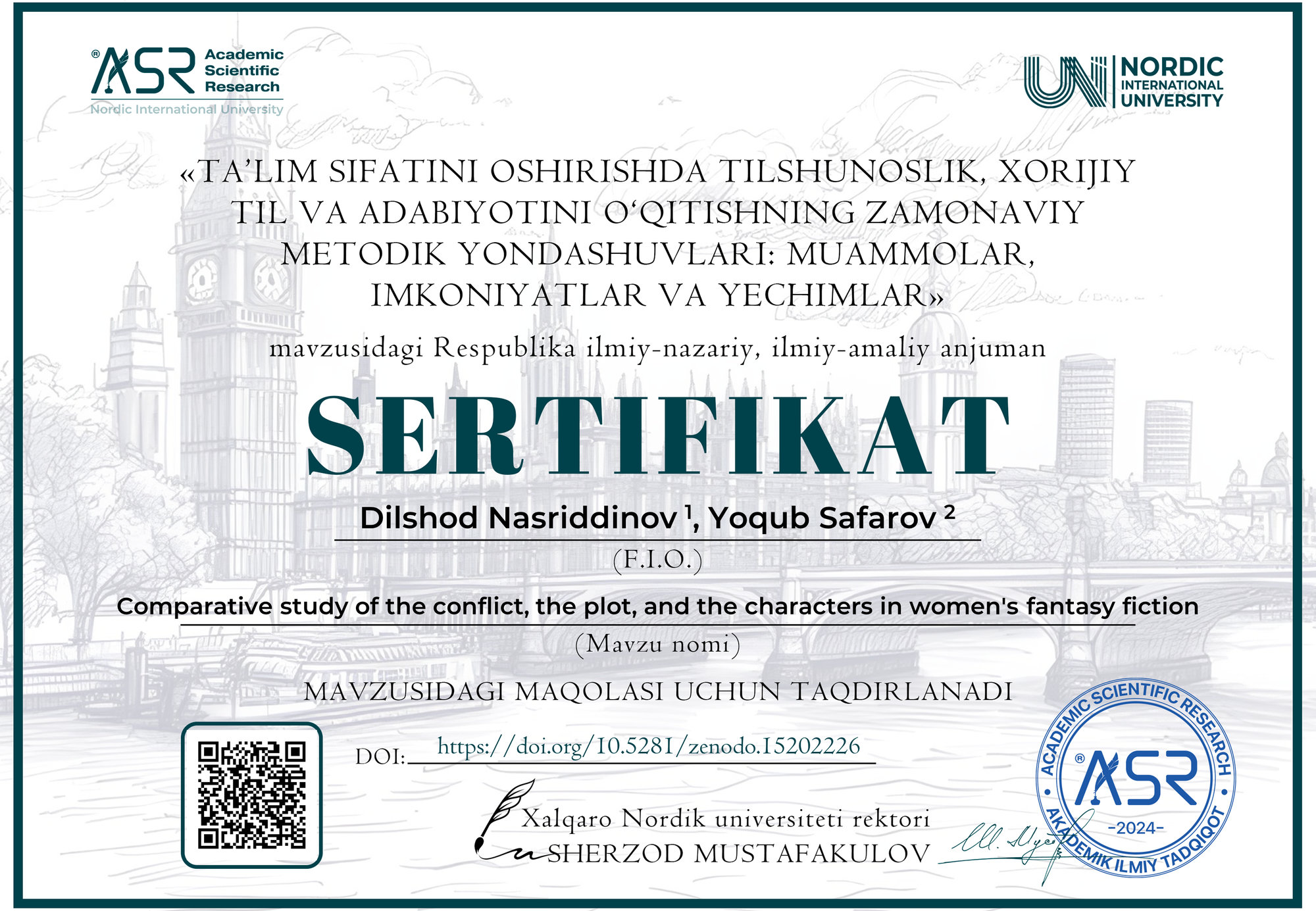Dilshod Nasriddinov 1, Yoqub Safarov 2

DOI: https://doi.org/10.5281/zenodo.15202226
Zenodo community: https://zenodo.org/records/15202226
Nordic_press journal: https://research.nordicuniversity.org/index.php/nordic/article/view/2354
MAQOLANI YUKLAB OLISH
SERTIFIKATNI YUKLAB OLISH
REVIEW:
The article "Comparative Study of the Conflict, the Plot, and the Characters in Women’s Fantasy Fiction" by Dilshod Nasriddinov and Yoqub Safarov offers an insightful and detailed analysis of the typological features in women’s fantasy literature, focusing specifically on the portrayal of conflict, plot structure, and character development. The authors critically examine the significant differences between classical and women’s fantasy, particularly in the interpretation of female images and the feminine principle, which the authors trace back to literary works such as Charlotte Brontë’s Jane Eyre.
The study effectively bridges the gap between classical fantasy literature, like the works of J.R.R. Tolkien and C.S. Lewis, and the more modern, popular works by female authors such as Ursula K. Le Guin and Maria Semenova. One of the central arguments presented is that while women’s fantasy shares many structural elements with male-oriented fantasy—such as the use of the quest narrative and self-sufficient fantastical worlds—it diverges significantly in its treatment of themes like love, the role of women, and character complexity.
The authors argue that in women’s fantasy, the role of love and relationships is often more central than in male-dominated fantasy. In classical works, such as Tolkien’s The Hobbit and The Lord of the Rings, romantic relationships are either peripheral or absent entirely. In contrast, women’s fantasy works such as A Wizard of Earthsea and Volkodav emphasize the emotional and relational dimensions of the story, where love conflicts drive both plot and character development. For instance, in Le Guin’s A Wizard of Earthsea, the protagonist Ged’s conflicts are intricately linked to his emotional relationships, most notably with the female characters who play crucial roles in his development.
Additionally, the article highlights the distinct portrayal of female characters in women’s fantasy. Unlike traditional archetypes such as the helpless damsel or the cold temptress, female characters in these works are multifaceted. Drawing on Jane Eyre, the authors explain that the female protagonist in women’s fantasy is not just a passive figure waiting to be saved but is often an active agent of change who simultaneously embodies both strength and vulnerability. This duality in female characters is further explored in works by Le Guin and Semenova, where female characters take on roles of both victim and savior, thus reflecting a complex and nuanced understanding of femininity.
The article also addresses the broader cultural implications of these portrayals. The authors argue that women’s fantasy, while not explicitly feminist in the radical sense, challenges traditional gender roles by presenting women as both powerful and compassionate, equal to men yet capable of nurturing and protecting. This complex vision of femininity serves as a critique of societal expectations and reinforces the evolving nature of gender identity in literature.
In conclusion, the study offers a compelling analysis of women’s fantasy literature, showing how it diverges from and simultaneously aligns with traditional fantasy tropes. The focus on emotional depth, character complexity, and the role of love within the plot makes women’s fantasy a rich and dynamic genre, capable of appealing to both feminist sensibilities and traditional readers. The authors’ comparison of different works effectively demonstrates how women’s fantasy literature, through its treatment of conflict, plot, and character, contributes to a broader cultural dialogue on gender, identity, and social values.



